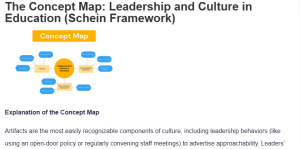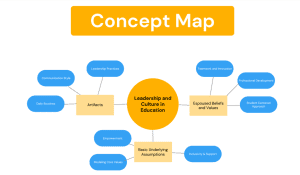The Concept Map: Leadership and Culture in Education (Schein Framework)
Explanation of the Concept Map
Artifacts are the most easily recognizable components of culture, including leadership behaviors (like using an open-door policy or regularly convening staff meetings) to advertise approachability. Leaders’ communication styles either encourage workers to work together or establish top-down decisions determining the nature of interaction (Millerd, n.d.). Moreover, short and frequent meetings or rituals such as morning meetings or ‘appreciation sessions’ introduce order into the organizational environment and constantly remind people of what is crucial according to leaders’ assessments.
Espoused Beliefs and Values include declared organizational priorities and the values that leadership actively promotes. For example, concern for staff training indicates that leadership cares about progress, meaning that leadership cares about enhancing professionalism. The student-centered point of view means that decisions made are in the best interest of students, positioning the organization and service (Millerd, n.d.). Likewise, developing job teamwork and creativity increases team cohesiveness and flexibility, which are values ideal in school systems.
Basic Underlying Assumptions are assumptions underpinning behavior and action and may not always be explicitly stated. For example, the abovementioned values, such as commitment to inclusivity and support, translate the value of respect and the belief in opportunities for all people, which leadership practices at Bluefin (Lew, 2018). Empowerment assumes that increased autonomy means better results, a concept leaders foster by decentralizing power (Millerd, n.d.). Lastly, benchmarking core values implies that leaders are supposed to act in ways that uphold the organizational set belief system, thus depicting the importance of leadership’s paragon on issues to do with integrity as well as conformity to the set organizational norms.
Ten Questions
- How do you ensure the organization’s core values are reflected in daily practices?
- What leadership practices have you found most effective in fostering a positive work culture (Lynch, 2012)?
- How do you handle conflicts between the organization’s values and individual beliefs?
- Can you describe how the organization’s core assumptions about education influence decision-making?
- How do you support staff aligning with the organization’s mission and values?
- What steps do you take to adapt leadership practices to changes in educational demands or challenges?
- How do you encourage a culture of professional growth and learning?
- How do you incorporate staff feedback to improve the organizational culture?
- How do you balance organizational traditions with the need for innovation?
- What role do you believe transparency plays in leadership and organizational culture?
References
Lew, C. (2018, January 16). The 3 elements of company culture–and why they really matter. Know Your Team.
Lynch, M. (2012). A guide to effective school leadership theories. Routledge.
Millerd, P. (n.d.) Edward Schein’s anxiety and assumptions: Powerful ideas on culture. Boundless.
ORDER A PLAGIARISM-FREE PAPER HERE
We’ll write everything from scratch
Question
Reflect on the educational organization where you currently work or one you are very familiar with. Consider the current working culture, observable leadership model(s), challenges, and positive attributes. Then use Schein’s framework of Artifacts, Espoused Beliefs and Values, and Basic Underlying Assumptions to create a concept map representing connections between leadership and the culture of your educational organization. Your map should include the three large categories identified from Schein with connections to specific leadership actions, practices, routines, tools, or other characteristics someone would see and hear in the educational organization you selected. There are numerous free online tools that can be used to create a concept map, and you may use a tool of your choice. Be sure your professor can view your submission without requiring a membership or subscription. In a 1 page paper, explain your concept map.

The Concept Map: Leadership and Culture in Education (Schein Framework)
- At the end of your paper, generate 10 questions about leadership roles that you would like to ask this, or another leader, in your upcoming interview.
Length: Concept map and 1 page paper with 10 questions for an interview.
Certificate of Completion for CITI’s Ethical Research Training (done )
References: Include a minimum of 3 scholarly sources (need 2 more)
- Edward Schein’s Anxiety and Assumptions: Powerful Ideas on Culture
Millerd, P. (n.d.) Edward Schein’s anxiety and assumptions: Powerful ideas on culture.
This overview offers insight into the development of organizational culture according to Edward Schein’s model.


